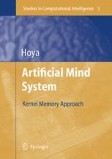Search
Search Results
-
Collision Free Motion Planning on Graphs
A topological theory initiated in [4,5] uses methods of algebraic topology to estimate numerically the character of instabilities arising in motion...
-
Coordinating Multiple Droplets in Planar Array Digital Microfluidics System
This paper presents an approach to coordinate the motions of droplets in digital microfluidic systems used for biochemical analysis. A digital...
-
Multi View and Multi Scale Image Based Visual Servo For Micromanipulation
In this article, we present vision-based techniques for solving some of the problems of micromanipulation. Manipulation and assembly at the micro...
-
From Classical Connectionist Models to Probabilistic/Generalised Regression Neural Networks (PNNs/GRNNs)
This chapter begins by briefly summarising some of the well-known classical connectionist/artificial neural network models such as multi-layered...
-
Data Mining and User Profiling for an E-Commerce System
Many companies are now develo** an online internet presence to sell or promote their products and services. The data generated by e-commerce sites...
-
Ontology-based Fuzzy Decision Agent and Its Application to Meeting Scheduling Support System
A Fuzzy Decision Agent (FDA) based on personal ontology for Meeting Scheduling Support System (MSSS) is proposed in this chapter. In this system,...
-
D-GridMST: Clustering Large Distributed Spatial Databases
In this paper, we will propose a novel distributable clustering algorithm, called Distributed-GridMST (D–GridMST for short), which deals with large...
-
A Probabilistic Approach to Mining Fuzzy Frequent Patterns
Deriving association rules is a typical task in data mining. The problem was originally defined for transactions of discrete items, but it was soon...
-
Data Mining of Missing Persons Data
This paper presents the results of analysis to evaluate the effectiveness of data mining techniques to predict the outcome for missing persons cases....
-
6 Beamforming Combined with Multi-channel Acoustic Echo Cancellation
For audio signal acquisition, beamforming microphone arrays can be efficiently used for enhancing a desired signal while suppressing...
-
4 Optimum Beamforming for Wideband Non-stationary Signals
Array processing techniques strive for extraction of maximum information from a propagating wave field using groups of sensors, which are located at...
-
Linkage Learning Genetic Algorithm
In order to handle linkage evolution and to tackle the ordering problem, Harik [47] took Holland’s call [53] for the evolution of tight linkage quite...
-
Preliminaries: Assumptions and the Test Problem
After introducing the background and motivation of the linkage learning genetic algorithm, we will start to improve and understand the linkage...
-
Modeling of Fuzzy Data
Fuzzy data are imprecise data obtained from measurements, perception or by interviewing people. Typically, those data are expressed in linguistic...
-
Data Driven Fuzzy Modelling with Neural Networks
Extraction of models for complex systems from numerical data of behavior is studied. In particular, systems representable as sets of fuzzy if-then...
-
Bioinformatics with Evolutionary Computation
This chapter makes the presumption that it is more important to understand the domain of the problem of interest and to pursue the best achievable...
-
A New Theoretical Framework for K-Means-Type Clustering
One of the fundamental clustering problems is to assign n points into k clusters based on the minimal sum-of-squares(MSSC), which is known to be...
-
Rough Set Theory with Applications to Data Mining
This paper is an introduction to rough set theory with an emphasis on applications to data mining. First, consistent data are discussed, including...
-
Intelligent Agents to Improve Adaptivity in A Web-Based Learning Environment
This chapter focuses on the use of intelligent agents in on-line learning environments in which educational organizations can equip students with...
-
Intelligent Agents that Learn to Deliver Online Materials to Students Better: Agent Design, Simulation and Assumptions
In this chapter, we discuss an integrated framework of case-based learning (CBL) in an agent that intelligently delivers learning materials to...
